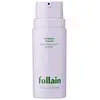What's inside
What's inside
 Key Ingredients
Key Ingredients

 Benefits
Benefits

 Concerns
Concerns

No concerns
 Ingredients Side-by-side
Ingredients Side-by-side

Water
Skin ConditioningGlycerin
HumectantBehenyl Alcohol
EmollientBakuchiol
AntimicrobialDicaprylyl Ether
EmollientGlyceryl Caprylate
EmollientRosa Canina Seed Oil
EmollientStearic Acid
CleansingCetearyl Alcohol
EmollientCalendula Officinalis Flower Extract
MaskingTocopherol
AntioxidantPentylene Glycol
Skin ConditioningCaprylhydroxamic Acid
Glyceryl Stearate
EmollientSodium Phytate
Xanthan Gum
EmulsifyingPolyglyceryl-3 Dicitrate/Stearate
EmulsifyingSodium Hydroxide
BufferingCitrus Aurantium Amara Peel Oil
Skin ConditioningWater, Glycerin, Behenyl Alcohol, Bakuchiol, Dicaprylyl Ether, Glyceryl Caprylate, Rosa Canina Seed Oil, Stearic Acid, Cetearyl Alcohol, Calendula Officinalis Flower Extract, Tocopherol, Pentylene Glycol, Caprylhydroxamic Acid, Glyceryl Stearate, Sodium Phytate, Xanthan Gum, Polyglyceryl-3 Dicitrate/Stearate, Sodium Hydroxide, Citrus Aurantium Amara Peel Oil
Water
Skin ConditioningGlycerin
HumectantPropanediol
SolventRosa Damascena Flower Water
MaskingIsoamyl Laurate
EmollientSodium Acrylate/Sodium Acryloyldimethyl Taurate Copolymer
Emulsion StabilisingBakuchiol
AntimicrobialGalactoarabinan
Isodecyl Neopentanoate
EmollientPalmitoyl Tripeptide-38
Skin ConditioningAcmella Oleracea Extract
Skin ProtectingNiacinamide
SmoothingAlaria Esculenta Extract
Skin ProtectingRosa Canina Fruit Oil
EmollientSodium Hyaluronate
Humectant1,2-Hexanediol
Skin ConditioningPolyisobutene
Caprylic/Capric Triglyceride
MaskingSodium Gluconate
Skin ConditioningCaprylhydroxamic Acid
Carbomer
Emulsion StabilisingCalcium PCA
HumectantCaprylyl/Capryl Glucoside
CleansingSodium Hydroxide
BufferingHydroxypropyl Cyclodextrin
MaskingWater, Glycerin, Propanediol, Rosa Damascena Flower Water, Isoamyl Laurate, Sodium Acrylate/Sodium Acryloyldimethyl Taurate Copolymer, Bakuchiol, Galactoarabinan, Isodecyl Neopentanoate, Palmitoyl Tripeptide-38, Acmella Oleracea Extract, Niacinamide, Alaria Esculenta Extract, Rosa Canina Fruit Oil, Sodium Hyaluronate, 1,2-Hexanediol, Polyisobutene, Caprylic/Capric Triglyceride, Sodium Gluconate, Caprylhydroxamic Acid, Carbomer, Calcium PCA, Caprylyl/Capryl Glucoside, Sodium Hydroxide, Hydroxypropyl Cyclodextrin
Ingredients Explained
These ingredients are found in both products.
Ingredients higher up in an ingredient list are typically present in a larger amount.
Bakuchiol is a plant-derived antioxidant (it's vegan!). It is often called the replacement for retinol although it is not part of the same family.
It has similar effects as retinol: skin smoothing, reducing discoloration, and preventing wrinkles. It does not cause as much irritation as traditional retinoids.
Bakuchiol works by breaking down free radicals and stimulating collagen production in skin.
Combining bakuchiol with retinol will not have adverse side effects. Studies show using them will just boost the benefits. Bakuchiol is also found to help stabilize retinol.
While bakuchiol does not make the skin more sun sensitive, we recommend wearing SPF on a daily basis.
Read more about traditional retinol
Learn more about BakuchiolCaprylhydroxamic Acid is a chelating agent.
Chelating agents help prevent metal ions from binding to other ingredients. This helps prevent unwanted reactions and effects from using the product.
Caprylhydroxamic Acid is often used with natural antimicrobial products as an alternative to preservatives.
Learn more about Caprylhydroxamic AcidGlycerin is already naturally found in your skin. It helps moisturize and protect your skin.
A study from 2016 found glycerin to be more effective as a humectant than AHAs and hyaluronic acid.
As a humectant, it helps the skin stay hydrated by pulling moisture to your skin. The low molecular weight of glycerin allows it to pull moisture into the deeper layers of your skin.
Hydrated skin improves your skin barrier; Your skin barrier helps protect against irritants and bacteria.
Glycerin has also been found to have antimicrobial and antiviral properties. Due to these properties, glycerin is often used in wound and burn treatments.
In cosmetics, glycerin is usually derived from plants such as soybean or palm. However, it can also be sourced from animals, such as tallow or animal fat.
This ingredient is organic, colorless, odorless, and non-toxic.
Glycerin is the name for this ingredient in American English. British English uses Glycerol/Glycerine.
Learn more about GlycerinSodium Hydroxide is also known as lye or caustic soda. It is used to adjust the pH of products; many ingredients require a specific pH to be effective.
In small amounts, sodium hydroxide is considered safe to use. However, large amounts may cause chemical burns due to its high alkaline.
Your skin has a natural pH and acid mantle. This acid mantle helps prevent harmful bacteria from breaking through. The acid mantle also helps keep your skin hydrated.
"Alkaline" refers to a high pH level. A low pH level would be considered acidic.
Learn more about Sodium HydroxideWater. It's the most common cosmetic ingredient of all. You'll usually see it at the top of ingredient lists, meaning that it makes up the largest part of the product.
So why is it so popular? Water most often acts as a solvent - this means that it helps dissolve other ingredients into the formulation.
You'll also recognize water as that liquid we all need to stay alive. If you see this, drink a glass of water. Stay hydrated!
Learn more about Water